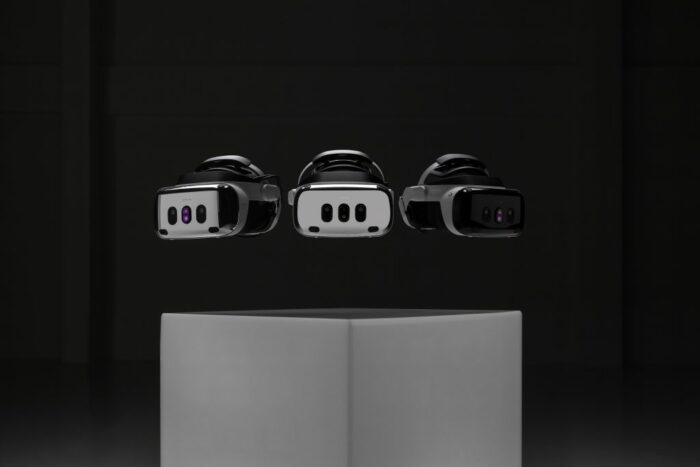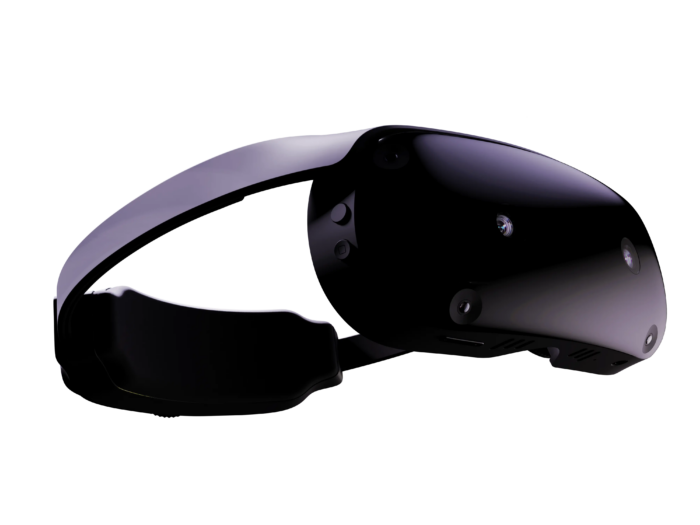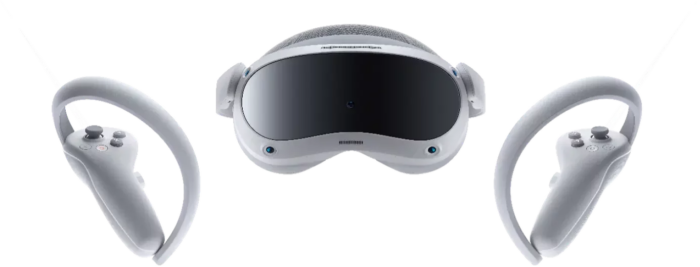[ad_1]
Over the last few years, virtual reality has made significant strides towards the mainstream. With the introduction of the Apple Vision Pro and the successful Meta Quest line of headsets by industry leader Meta, virtual reality, a key element of mixed reality, is gaining recognition as a compelling alternative to traditional entertainment systems.
In this context, this article aims to pique your interest by spotlighting the innovative and pioneering Virtual Reality companies to watch in 2023. We’ll delve into their unique offerings, emerging trends, and the pivotal role of VR in shaping the future and provide a comprehensive FAQ section addressing your most pressing questions. VR, this article is your go-to resource for virtual reality companies.
Top 6 Virtual Reality Companies
1. Meta
Meta, originally known as Facebook, is a pioneering mixed reality provider that practically coined the word Metaverse and took it to the mainstream. A fundamental component of the company’s business plan is virtual reality, which it Kickstarter in 2014 through its acquisition of VR maestro Oculus for $2 billion. Now, Meta is a leading provider of VR and mixed reality headsets through its line of Meta Quest devices. Although it is well documented that Meta’s VR business (Reality Labs is losing a substantial amount of money, there is no denying that without Meta, VR wouldn’t be as popular as it is today due to its competitive price points and large library of games and services. Despite losses, Meta continues to double down on its mixed reality devices with a special focus on augmented reality, as demonstrated through its Rayband Meta Smart Glasses.
2. Apple
From a revenue standpoint, Apple is the largest company in the virtual reality space and another company that has put VR into the mainstream consciousness with Apple Vision Pro. Coming in at over $3000, the Vision Pro took the world by storm when it was released last year, with consumers wearing the headset in various situations reminiscent of sci-fi films such as Ready Player One and The Matrix. Despite the Apple Vision Pros’ hefty price tag, the headset has done very well, which aligns with predictions that give Apple the confidence to double down on its mixed reality endeavors. The headset has sold around 200,000 units since its release only a few months ago. According to reviewers, it is one of the best mixed-reality headsets ever created. Thus, Apple and its headset are here to stay in the virtual reality space.
3. Varjo

Varjo is a Finnish company specializing in creating mixed-reality headsets that specialize in manufacturing. Having a disclosed funding of over $169,030,969 from the likes of Nordic Secondary Fund, the company specializes in creating groundbreaking headsets for bespoke use cases and personnel such as astronauts and pilots. Their latest headset, the Varjo XR-4 series, stands above the rest regarding the field of view capabilities and immersion, offering unparalleled virtual experiences in the enterprise. All in all, Varjo stands at the top in terms of Virtual Reality prowess.
5. Ajna Lens

Ajna Lens is a leading virtual reality provider located in Thane, India. The company specializes in using VR and mixed reality to enhance the skill set of the APAC region through educational-based outcomes using VR. As a pioneer in VR and education in India, Ajna Lens stands at the forefront of VR-led education. Ajna Lens’s most recent headset, the AjnaXR Enterprise Edition VR headset, boasts impressive power with the latest snapdragon processor and pancake lenses/
6. Pico

Pico, a subsidiary of Bytedance based in China, is a leading provider of virtual reality (VR) and mixed reality (MR) headsets. Renowned for its wide range of products, it is often seen as Meta’s main competitor in the VR market. Pico’s latest offerings, including the Pico 4 and enterprise editions, demonstrate its commitment to innovation. While praised for its competitive pricing and high quality, Pico faces challenges in usability due to the limited availability of applications and experiences in its app store, a common issue in the industry. Additionally, Pico explores mixed reality, offering immersive experiences that blend the digital and physical worlds.
Emerging Trends in Virtual Reality
The virtual reality space is dynamic and constantly changing, with various emerging trends shaping its future. Firstly, mainstream gaming is starting to adopt immersive experiences, with PlayStation leading the way through its PlayStation VR line of headsets. Although we are a long way from virtual reality becoming a staple hold of the average gaming household, we are seeing increased adoption of VR games across the board, with developers taking mixed reality seriously as a viable alternative to controller and mouse with VR games offering the same if not better quality experiences in gaming. For example, virtual reality games like Asgard’s Wrath 2 are deemed one of the best VR games, with near-perfect scores of ten out of ten from traditional gaming outlets like IGN. Thus, through developer adoption hiking up quality, VR gaming is becoming mainstream, with enthusiasts picking up these headsets to play the latest and best games.
Another emerging trend is an increased focus on enterprise and workplace solutions utilizing VR. As mentioned above, with the release of high-end enterprise-grade headsets like the Vision Pro, workplace solutions are becoming more viable alternatives to laptops and desktop PCs. Hence, we are seeing a large increase in employees using these devices at home to conduct work, such as using the Apple Vision Pro to overlay meetings digitally.
Thirdly, from the industrial standpoint, we are seeing a rapid adoption in using virtual reality in the likes of healthcare to simulate surgeries or in treatment, for example, in reducing PTSD in patients. Thus, virtual reality is beginning to have a major role in healthcare. Similarly, healthcare is not the only industry utilizing VR; sports, hospitality, tourism, and others are also beginning to use the hardware.
The Role of VR Companies in Shaping the Future
As mentioned above, virtual reality and, by extension, companies will significantly impact the future of industry, enterprise, and society. We will see a paradigm shift in the use and utilization of VR to enhance our everyday lives. From life-saving surgery to increased productivity at work, virtual reality is gradually becoming a part of our everyday lives.
Companies such as Apple, Meta, and Varjo continue pushing the boundaries of what is possible with technology, ensuring that VR will become the future. Despite this, we still have much to go regarding VR adoption and enabling technology development. Despite progress, the current technology needs more seamlessness and limitations in passthrough technology and immersion. However, we expect to see these issues ironed out in the future.
FAQ about Virtual Reality Companies
How do I choose the right virtual reality company for my project?
The right Virtual reality company depends on your needs and specific use cases. As a rule of thumb, we can divide the industry into three parts: Industrial (use cases outside a business remit), Enterprise (use cases within a business), and Social (social-led experiences). These categories can guide you toward your needs. For more information, check out our intelligence platform so you can pick the right one.
How does virtual reality enhance user experience?
Virtual Reality is critical in enhancing user experiences, from more immersion when gaming to assisting you when you conduct life-saving surgery on a patient. VR opens the door to many user experiences that depend on your needs.
What industries benefit the most from virtual reality solutions?”
There is no specific industry that benefits most from VR solutions. However, healthcare, tourism, and gaming are rapidly increasing their adoption due to virtual reality’s intuitive use cases.
[ad_2]
Read More: metaverseinsider.tech











 Bitcoin
Bitcoin  Ethereum
Ethereum  Tether
Tether  XRP
XRP  Solana
Solana  USDC
USDC  TRON
TRON  Dogecoin
Dogecoin  Lido Staked Ether
Lido Staked Ether  Cardano
Cardano  Wrapped Bitcoin
Wrapped Bitcoin  Hyperliquid
Hyperliquid  Wrapped stETH
Wrapped stETH  Bitcoin Cash
Bitcoin Cash  Sui
Sui  Chainlink
Chainlink  LEO Token
LEO Token  Avalanche
Avalanche  Stellar
Stellar  USDS
USDS  Toncoin
Toncoin  Shiba Inu
Shiba Inu  WhiteBIT Coin
WhiteBIT Coin  WETH
WETH  Litecoin
Litecoin  Wrapped eETH
Wrapped eETH  Binance Bridged USDT (BNB Smart Chain)
Binance Bridged USDT (BNB Smart Chain)  Hedera
Hedera  Monero
Monero  Bitget Token
Bitget Token  Ethena USDe
Ethena USDe  Polkadot
Polkadot  Coinbase Wrapped BTC
Coinbase Wrapped BTC  Uniswap
Uniswap  Pi Network
Pi Network  Pepe
Pepe  Aave
Aave  Dai
Dai  Ethena Staked USDe
Ethena Staked USDe  Aptos
Aptos  OKB
OKB  Bittensor
Bittensor  BlackRock USD Institutional Digital Liquidity Fund
BlackRock USD Institutional Digital Liquidity Fund  Jito Staked SOL
Jito Staked SOL  NEAR Protocol
NEAR Protocol  Internet Computer
Internet Computer  Cronos
Cronos  Ethereum Classic
Ethereum Classic  sUSDS
sUSDS